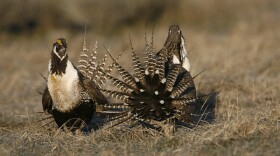The Bureau of Land Management and the U.S. Forest Service has announced a new plan to protect the greater sage grouse from extinction, while hoping to prevent the bird from being added to the endangered species list.
The sage grouse population has dropped from 16 million birds to less than half a million, mainly due to lost sagebrush habitat. The bird's range spans 11 western states including Colorado.
"As land managers of two-thirds of greater sage grouse habitat, we have a responsibility to take action that ensures a bright future for wildlife and a thriving western economy," said Secretary of the Interior Sally Jewell at the announcement in Cheyenne, Wyoming.
Wildfires, invasive species, and development are the biggest habitat threats for the sage grouse, Jewell said. The proposal includes several efforts to reduce habitat fragmentation, including caps on development and minimizing oil and gas drilling on sagebrush lands and expansion for mining operations. The proposal would also limit transmission lines and pointed to and solar projects as a negative impact to the birds.
Federal-state efforts will protect sage grouse & 350+ other species, as well as West's ranching heritage & outdoor rec economy.SJ
— Sally Jewell (@SecretaryJewell)
States like and Colorado have been working for years on local efforts to protect the bird. More recently, Gov. John Hickenlooper has issued an asking state agencies to beef up their sage grouse efforts and set up a process to review oil and gas regulations to mitigate impacts.
The order also creates a to preserve sage grouse lands. Energy companies and others that disturb habitat could pay landowners who create or improve sage grouse territory.
"We firmly believe that state-led efforts provide the most effective approach to protecting and conserving the species and its habitat," said Hickenlooper. "The listing of the greater sage-grouse under the [Endangered Species Act] would have a significant and detrimental economic impact on the state."
The governor said he was cautiously optimistic about the latest federal plan, but his office still needed time to review the many documents.
"We've had a strong partnership with the Interior Department, and while we still have some difficulties with the BLM's approach, we remain committed to keep working through those issues," said Hickenlooper.
Meanwhile Western Energy Alliance, which represents oil and gas companies in the West said a one-size-fits-all federal approach would not be beneficial, and would detract from conservation efforts companies are already doing.
"The economic impact of sage grouse restrictions on just the oil and natural gas industry will be between 9,170 and 18,250 jobs and $2.4 billion to $4.8 billion of annual economic impact across Colorado, Montana, Utah and Wyoming," said Kathleen Sgamma, vice president of government and public affairs at Western Energy Alliance.
The U.S. Fish and Wildlife Services is expected to make a decision in September 2015 about whether to put the sage grouse on the endangered species list.
Fact sheet on ’s new plan, announced today:
— Dan Boyce (@BoyceDan)
Editor's Note: This story has been updated with comment from Colorado Gov. John Hickenlooper and from the Western Energy Allinace.






